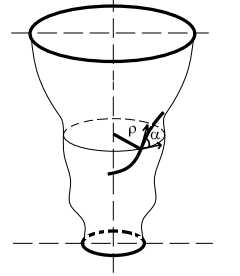GEODESIC of a surface
From the Greek gê "Earth" and daiein
"share, divide".
Other name (from Navigation vocabulary): orthodromy,
from the Greek orthos "right" and dromos "race". |
The geodesic lines of a surface,
which are, in a way, the "straight lines" of this surface, have several
equivalent definitions:
DEF #1 (mechanical): they are the trajectories of a massive
point moving on the surface and only subject to the normal reaction; we
can physically create them by making small balls roll on the surface (on
the concave side), in a state of weightlessness (with a weight, these lines
become flow lines)
DEF #2 (mechanical): they are the equilibrium figures
of an inextensible homogeneous massive wire placed on the surface, in a
state of weightlessness (with a weight, these figures become the
catenaries)
DEF #3: they are the curves traced on the surface such
that, at every point, the principal normal of the curve (if it exists)
coincides with the normal of the surface (in other words, such that the
osculating plane of the curve contains the normal of the surface, or even
that the rectifying plane of the curve is the tangent plane of the surface).
DEF #4: they are the curves traced on the surface such
that, at every point, the normal curvature of the curve (i.e. the curvature
of the normal section of the surface in the direction of the tangent to
the curve) is equal in absolute value to the curvature of the curve.
DEF #5: they are the curves traced on the surface with
zero geodesic curvature: figuratively, they are the trajectories of observers
moving on the surface by walking straight ahead of them, or of small cars
the direction of which is blocked in a linear position.
The geodesics of a surface are the curves the geodesic
torsion of which is equal to the torsion: the general case gives the pseudogeodesics.
In general, by every point of the surface passes, in a
given direction, one and only one geodesic, and by two points pass at least
one geodesic (this property is a generalization of Euclid's axioms, but
for a surface that is not isometric to the plane, everything lies in the
"in general"!)
It can be proved that any arc joining two points on the
surface, of minimal length, is a geodesic, but there can be geodesics joining
two points, and not having the minimal length (for example two points of
a generatrix of a cylinder of revolution are also joined by a cylindrical
helix, which is longer, but is a geodesic nonetheless).
However, for any point B sufficiently close to
a point A of the surface, there exists a unique geodesic joining
A to B, necessarily realizing the minimum of the geodesic
distance from A to B.
Examples:
- the geodesics of the plane
are the straight lines
- the geodesics of the sphere
are the great circles and are also called orthodromies.
see also www.dms.umontreal.ca/~terrierj/geodsursphere.html
- the geodesics of a cylinder
or a cone, and more generally of developable
surfaces are the curves that transform into lines when the surface is applied
onto a plane; for the cylinder of revolution, they are the
cylindrical
helices (or circles or lines), and see the geodesics of the
cone
of revolution on its own page.
- the geodesics of the paraboloid
of revolution are on its page, same for the ellipsoid
of revolution.
- the geodesics
of the torus lead to calculations with elliptic integrals.
- the meridians of a
surface
of revolution are geodesics (but not the parallels, except those with
extreme radius).
- the straight lines of a surface
are geodesics (and they are the only one to be geodesics and asymptotic
lines).
- a geodesic of a surface is planar
if and only if it is a curvature line.
- the evolutes
of a skew curve are geodesics of the polar
developable of the curve.
See also the brachistochrones,
the timewise shortest curves, and the pseudogeodesics,
curves the osculating plane of which forms a constant angle with the tangent
plane (right angle in the case of geodesics).
© Robert FERRÉOL
2018
i.e.
(see the notations).
does not limit the generality (it leads to a normal parametrization of
the geodesic); we get the differential system:
that can be written,
.
